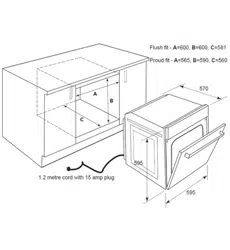Loading ...
Loading ...
Loading ...

GUIDE TO USING YOUR OVEN
The Cooling Fan Feature
Our ovens have a cooling fan that keeps all the exposed surfaces cool, protects your kitchen cabinets and reduces
the amount of steam vapour in the oven. The cooling fan continues to run after the end of the cooking cycle. The
fan will stop automatically once the residual heat in the oven has dissipated.
Dish Selection and Use
The colour, material and thickness of a baking dish affects the cooking time.
Aluminium, ceramic, glass and shiny dishes reduce cooking and base browning. By comparison dark coloured dishes
and enamelled cast iron type heavy dishes increase cooking and base browning.
Remember - all ovens are different and your oven may perform differently to your previous oven.
Oven Shelves
Consider the shelf height for the item being cooked and the function selected
Pre-heating
For best results we recommend pre-heating the oven for 30 minutes to get it good and saturated with heat to the
correct temperature except when grilling, as that function barely needs any pre-heating.
Condensation and steam
The oven has a fan inside the oven which circulates the air on fan assisted functions. It reduces cooking time and
energy consumption by recirculating the hot steam in the cavity.
During cooking, steam may be produced and released when the door is opened which is completely normal. To
reduce moisture build up in the oven pre heat prior to cooking and wipe the oven down after each use. Excessive
moisture can damage the oven and cause leakage under the door.
Hints and tips
Your oven may bake or roast differently to the oven you had before. We work and test very hard to achieve optimal
performance in our ovens but sometimes there is a degree of experimentation with temperature and shelf position
to reach the performance levels you are used to. Cooking a simple ‘packet’ cake using exactly the instructions on
the box can be a good start to understand the unique characteristics of your oven.
We also suggest using a lower temperature setting to start with and then work from there. When cooking on
multiple shelves we suggest adding a bit more time to the cooking cycle.
Make sure your oven dishes fit into the oven before turning it on and allow about 40mm clearance to the side of the
oven so that hot air can circulate freely while cooking.
Always remove uneccessary trays from the oven when cooking. They affect the flow of air and the performance of
the oven.
The benefit of cooking in an oven bag is that food tends not to dry out and the oven remains clean during cooking.
Warnings about care and cleaning - It is healthier and safer to keep the oven clean.
DON’T touch the elements inside the oven.
DON’T use strong detergents as they can leave spotting and corrosion marks.
DON’T use a steam cleaner as it can build up moisture in the oven and electrics.
DON’T use sharp implements as they can scratch the surfaces.
DON”T use abrasive cleaners, powder cleaners, steel wool or waxy cleaning agents.
DON’T use abrasive cleaners on the glass door as this can weaken the door glass and may lead to shattering.
DON’T let fats and oils build up in your oven. They are a fire hazard and can create smoke and nasty odours.
DON’T let the grill tray build up with fats and oils as they can flare up during the grill cycle
DONT use polyunsatured oils in the oven. They leave a residue that is much harder to remove.
9
Loading ...
Loading ...
Loading ...
